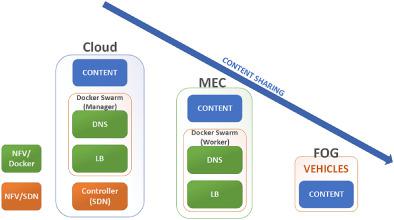当前位置:
X-MOL 学术
›
Trans. Emerg. Telecommun. Technol.
›
论文详情
Our official English website, www.x-mol.net, welcomes your
feedback! (Note: you will need to create a separate account there.)
A platform for cloudification of network and applications in the Internet of Vehicles
Transactions on Emerging Telecommunications Technologies ( IF 2.5 ) Pub Date : 2020-04-27 , DOI: 10.1002/ett.3961 Francisco Edigleison da Silva Barbosa 1 , Francisco Ferreira Mendonça Júnior 1 , Kelvin Lopes Dias 1
Transactions on Emerging Telecommunications Technologies ( IF 2.5 ) Pub Date : 2020-04-27 , DOI: 10.1002/ett.3961 Francisco Edigleison da Silva Barbosa 1 , Francisco Ferreira Mendonça Júnior 1 , Kelvin Lopes Dias 1
Affiliation

|
Vehicular networks have evolved from traditional vehicle‐to‐vehicle (V2V) and vehicle‐to‐infrastructure (V2I) communications to the so‐called Internet of Vehicles (IoV), which encompasses cloud computing and the Internet of Things. Thus, IoV creates novel scenarios and applications such as autonomous driving, as well as research challenges regarding the requirements for connected cars such as ultra‐reliable low‐latency, communications and the need for high processing power closer to vehicles. In order to address the above issues for IoV, this article proposes integrating state‐of‐the‐art technology pillars that are well accepted by both industry and academia as building blocks for future 5G networks. We propose a flexible, hierarchical, and scalable IoV architecture that integrates software‐defined networking, edge/fog computing, network function virtualization, and containers. We evaluate the proposal in both infrastructure‐based and peer‐to‐peer content distribution scenarios. The results are promising and point out that the architecture can cope with the stringent requirements that need to be met in terms of latency for 5G‐based IoV applications.
中文翻译:

车联网中网络和应用程序云化的平台
车载网络已经从传统的车对车(V2V)和车对基础设施(V2I)通信发展到涵盖云计算和物联网的所谓的车联网(IoV)。因此,IoV创造了诸如自动驾驶之类的新颖场景和应用,以及有关互联汽车需求的研究挑战,例如超可靠的低延迟,通信以及对更接近汽车的高处理能力的需求。为了解决IoV的上述问题,本文建议将行业和学术界都认可的最新技术支柱作为未来5G网络的基础。我们提出了一种灵活,分层且可扩展的IoV架构,该架构集成了软件定义的网络,边缘/雾计算,网络功能虚拟化和容器。我们在基于基础架构的内容和对等内容分发方案中评估该提案。结果令人鼓舞,并指出该架构可以满足基于5G的IoV应用的延迟方面需要满足的严格要求。
更新日期:2020-04-27
中文翻译:

车联网中网络和应用程序云化的平台
车载网络已经从传统的车对车(V2V)和车对基础设施(V2I)通信发展到涵盖云计算和物联网的所谓的车联网(IoV)。因此,IoV创造了诸如自动驾驶之类的新颖场景和应用,以及有关互联汽车需求的研究挑战,例如超可靠的低延迟,通信以及对更接近汽车的高处理能力的需求。为了解决IoV的上述问题,本文建议将行业和学术界都认可的最新技术支柱作为未来5G网络的基础。我们提出了一种灵活,分层且可扩展的IoV架构,该架构集成了软件定义的网络,边缘/雾计算,网络功能虚拟化和容器。我们在基于基础架构的内容和对等内容分发方案中评估该提案。结果令人鼓舞,并指出该架构可以满足基于5G的IoV应用的延迟方面需要满足的严格要求。











































 京公网安备 11010802027423号
京公网安备 11010802027423号